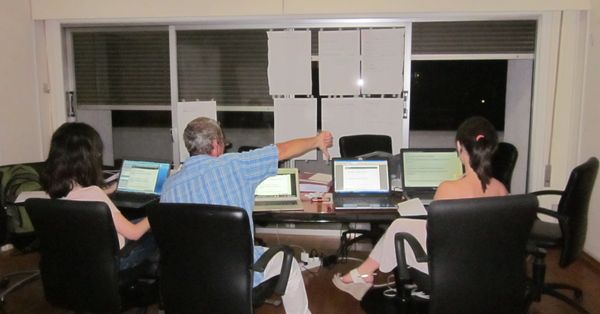2008 Historic Virtual SDDP: Difference between revisions
No edit summary |
No edit summary |
||
| Line 6: | Line 6: | ||
In the context of Obama's vision for engaging stakeholders from all walks of life in a bottom-up democracy employing Internet technology, what factors do we anticipate, on the basis of our experiences with SDDP, will emerge as inhibitors to the actualization of his vision? | In the context of Obama's vision for engaging stakeholders from all walks of life in a bottom-up democracy employing Internet technology, what factors do we anticipate, on the basis of our experiences with SDDP, will emerge as inhibitors to the actualization of his vision? | ||
The picture below immortalized a moment during which the 3 Facilitators based in Cuprus were captured at a moment when the result of a vote was "No". | The picture below immortalized a moment during which the 3 Facilitators based in Cuprus were captured at a moment when the result of a vote was "No". The Lead facilitator, [[Aleco Christakis]] as asking the participants to respond whether one of identified challenges was aggravating another. In such a dilemma, a "Yes" is taken only when more than 2/3 (or sometimes 3/4) of the participants vote for a "Yes". In this case, not enough, as shown by the he resultgesture of [[Yiannis Laouris]], in the middle, who was in charge of entering the outcome of the voting on the [[Cogniscope]] software. [[Elia Petridou]] on the right, was in charge of transmitting her (cogniscope) computer screen to all participants, while [[Maria Georgiou]], on the left, was documenting the discussions and periodically updating, printing, and posting notes in front of the facilitators (shown on the window). | ||
[[File:VirtualSDD_Obama2008_02.JPG|600px]] | [[File:VirtualSDD_Obama2008_02.JPG|600px]] | ||
Revision as of 10:20, 15 January 2021
The first attempt made by Future Worlds Center pionners to organize a fully virtual [Structured Democratic Dialogue Process]] has taken place in 2008. An international panel of 15 experts in e-democracy supported by a team of 5 structured dialogue experts were engaged for 3 weeks in asynchronous and synchronous virtual interactions. The Both the Participants and the Facilitators were spread across continents. The subject of inquiry was to identify key obstacles that could potentially prevent an ambitious vision for the newly elected Obama Administration from being implemented. The SDDP Obamavision co-laboratory used as Triggering Question:
In the context of Obama's vision for engaging stakeholders from all walks of life in a bottom-up democracy employing Internet technology, what factors do we anticipate, on the basis of our experiences with SDDP, will emerge as inhibitors to the actualization of his vision?
The picture below immortalized a moment during which the 3 Facilitators based in Cuprus were captured at a moment when the result of a vote was "No". The Lead facilitator, Aleco Christakis as asking the participants to respond whether one of identified challenges was aggravating another. In such a dilemma, a "Yes" is taken only when more than 2/3 (or sometimes 3/4) of the participants vote for a "Yes". In this case, not enough, as shown by the he resultgesture of Yiannis Laouris, in the middle, who was in charge of entering the outcome of the voting on the Cogniscope software. Elia Petridou on the right, was in charge of transmitting her (cogniscope) computer screen to all participants, while Maria Georgiou, on the left, was documenting the discussions and periodically updating, printing, and posting notes in front of the facilitators (shown on the window).
Facilitators
| Name | City |
|---|---|
| Aleco Christakis | Archanes, Crete |
| Gayle Underwood | Allegan, Michigan, USA |
| Yiannis Laouris | Nicosia, Cyprus |
| Elia Petridou | Nicosia, Cyprus |
| Maria Georgiou | Nicosia, Cyprus |







